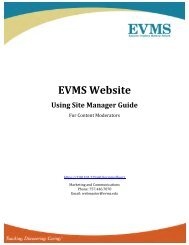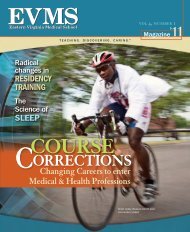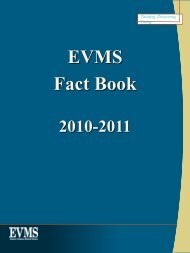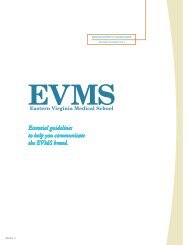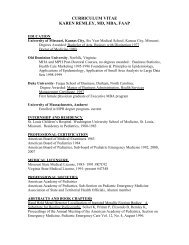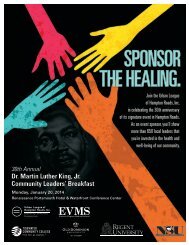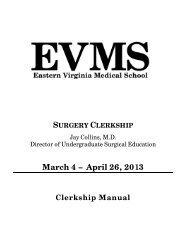in Hampton Roads in Hampton Roads - Eastern Virginia Medical ...
in Hampton Roads in Hampton Roads - Eastern Virginia Medical ...
in Hampton Roads in Hampton Roads - Eastern Virginia Medical ...
You also want an ePaper? Increase the reach of your titles
YUMPU automatically turns print PDFs into web optimized ePapers that Google loves.
New Productor TreatmentOnce a product has been developed <strong>in</strong>the laboratory and tested successfully onanimals, then cl<strong>in</strong>ical trials on humanscan beg<strong>in</strong>.Submitted forreviewIRB ReviewEnsur<strong>in</strong>g safetyand effectivenessheadache, warts, what have you,” Dr. Archer says. “Cl<strong>in</strong>ical trials are how weprove that those products are effective.”In other words, to see if they do what they say they do.The products or treatments be<strong>in</strong>g tested may come from an EVMS researcher,a pharmaceutical company or other sources. Once a product has been developed<strong>in</strong> the laboratory and tested successfully on animals, then cl<strong>in</strong>ical trials onhumans can beg<strong>in</strong>.“It’s a long process,” says Aaron I. V<strong>in</strong>ik, MD, scientific director at the EVMSStrelitz Diabetes Center, another physician with decades of research experience.“There is a need for vigilance and attention to make sure the drugs are safeand effective.”Research on humans takes place <strong>in</strong> sequential phases. In Phase I trials,researchers test the drug or treatment on a small number of people —sometimes as few as a dozen — to gauge safety and effectiveness andlook for side effects. In Phase II and Phase III, the test groups are progressivelylarger. Phase III trials may also compare the product to others already on themarket as a way of ensur<strong>in</strong>g the new concept improves upon what’s alreadyavailable. Phase IV trials may take place after the product is on the market, togather more <strong>in</strong>formation and ensure its long-term safety.Fewer and fewer drugs make it to the later stages of test<strong>in</strong>g, as <strong>in</strong>effective orunsafe products are weeded out. It is a rigorous, time-consum<strong>in</strong>g process, butresearchers say it’s all to ensure only the best treatments reach the market. Thetremendous rate of attrition means as few as one <strong>in</strong> 20 new compounds makesit to the f<strong>in</strong>al phase of test<strong>in</strong>g.Every step of the process is overseen by the Food and Drug Adm<strong>in</strong>istration,the researchers and the EVMS Office of Research Subjects Protection. TheEVMS office oversees two Institutional Review Boards (IRB), which are chargedwith protect<strong>in</strong>g the safety and legal rights of participants <strong>in</strong> cl<strong>in</strong>ical trials.The volunteer review boards are made up of physicians from a variety ofEVMS departments as well as scientists, adm<strong>in</strong>istrators and people outside ofthe school.Before any cl<strong>in</strong>ical trial can beg<strong>in</strong>, <strong>in</strong>vestigators must apply to the reviewboard.“We look at what are the risks versus the benefits to society,” says Robert F.Williams, PhD, associate dean for research subjects protection. “The benefitsmust outweigh the risks.”Before the IRB approves a trial, its members look <strong>in</strong>to everyth<strong>in</strong>g from thetrial’s procedures to the recruitment process to compensation, which must notPhase I TrialsSmall control grouptest<strong>in</strong>gPhase II TrialsTest group expandsPhase III TrialsTest group expandsaga<strong>in</strong> and <strong>in</strong>cludescomparisons toexist<strong>in</strong>g productsPhase IV TrialsMarket placementfollow-upcl<strong>in</strong>ical trials www.eVMS.EDU fall 2009 17



